On a drizzly, overcast afternoon, all is quiet at the intersection of Bartholomew and Prieur streets in New Orleans’ historic Ninth Ward. The quiet neighborhood around the Ellis Marsalis Center for Music (EMCM) feel worlds away from the historic French Quarter packed with jazz clubs, bars, restaurants, and markets.
At 3 p.m., the tempo begins to shift – slowly at first, as youth ranging in age from 8 to 18 file through the blue building’s front gate, instruments in tow. The hallways grow steadily louder with the sounds of laughter, footsteps, stray musical notes, and teachers greeting their students. The fledgling musicians begin cycling through their four classes for the day: piano, homework help, an instrument of their choosing, and coding – a required course that stems from the center’s ongoing partnership with Apple.
Launched in 2019, the collaboration with Apple has allowed EMCM to expand its curriculum, adding a suite of tech-focused courses that complement the world-class music education the center provides to students.
“I know some people wonder, ‘Why is a music institution teaching coding?’ For us, it’s all connected – it’s part of a digital tapestry,” says Lisa Dabney, the center’s executive director. “It’s about closing the digital divide by giving students access to technology and introducing them to different types of diverse, long-term career opportunities, including pathways in music technology and beyond. In a community where many homes lack access to iPads and computers, this partnership with Apple helps us put the power of technology directly in our students’ hands, opening doors to creative and professional futures they might have never imagined.”
The center’s piano students regularly use apps on iPad to reinforce what they’re learning, both inside and outside of the classroom.
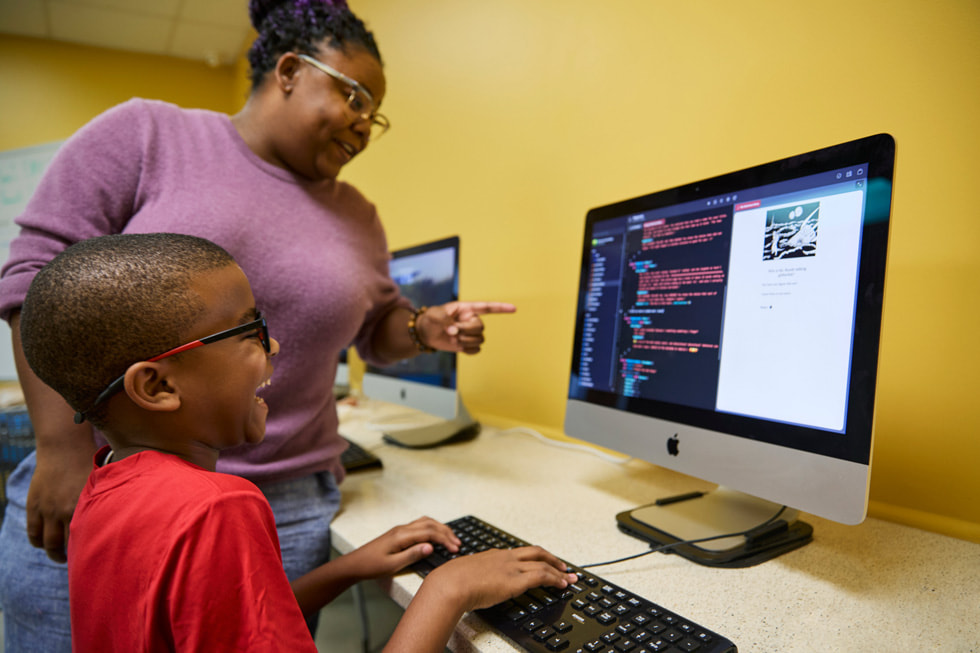
Coding is a required course at EMCM. In the campus’s Mac lab, instructors like LaTasha Bundy (shown here with Jahaad Appleberry) teach students the foundations using Swift Playgrounds.
Apple’s support for EMCM is part of the company’s broader long-standing commitment to uplift and amplify youth creativity in New Orleans through technology. As budding musicians at EMCM learn to code and mix new tracks with Logic Pro and GarageBand, students at Delgado Community College are producing their own podcast about local cultural icons, and young artists at Arts New Orleans have used iPad to design a new mural fans will see on their way to the Superdome this weekend.
“We love to see technology and creativity supporting one another, and it’s such a joy to see that in action here in my hometown of New Orleans,” said Lisa Jackson, Apple’s vice president of Environment, Policy, and Social Initiatives. “Creativity, art, and music are in our DNA. Our teams are really excited to keep working with our amazing community partners and the talented young people who light up this city.”
Founded in 2012 in New Orleans’ Ninth Ward, the Ellis Marsalis Center for Music serves as a hub for the community, offering students a foundational education in music and technology.
EMCM’s holistic and ever-evolving programming stems directly from its namesake, who wanted to ensure that the next generation had the chance to carry on the city’s vibrant cultural legacy. This work felt especially important in the Ninth Ward – a neighborhood renowned for being home to many iconic musicians, civil rights activists, and educators – that had been disproportionately impacted by Hurricane Katrina in 2005.
“At the heart of the center’s curriculum is our founder’s belief that truly understanding music begins with learning to hear it,” explains Dabney. “Piano plays a key role in this process by helping students develop critical listening skills, connect deeply with music, and build a strong foundation in music theory. For this reason, piano has been a required class for all students, in addition to their primary instrument.”
That same foundational approach to learning now extends to coding and audio engineering courses. In the center’s Mac lab, students use the latest hardware and software to learn coding basics with Apple’s Everyone Can Code and Swift Playgrounds frameworks. And in the on-site music studio, they learn how to engineer their own tracks with apps like GarageBand and Logic Pro. Students also get access to their own iPad every semester, allowing them to take what they’ve learned in their classes and build on those skills at home.
This is a job you can learn now, and for the rest of your life, you can do it. If you learn how to capture and edit audio at a young age, you can evolve that into a career.
Dr. Daryl Dickerson, Ellis Marsalis Center for Music’s director of music education
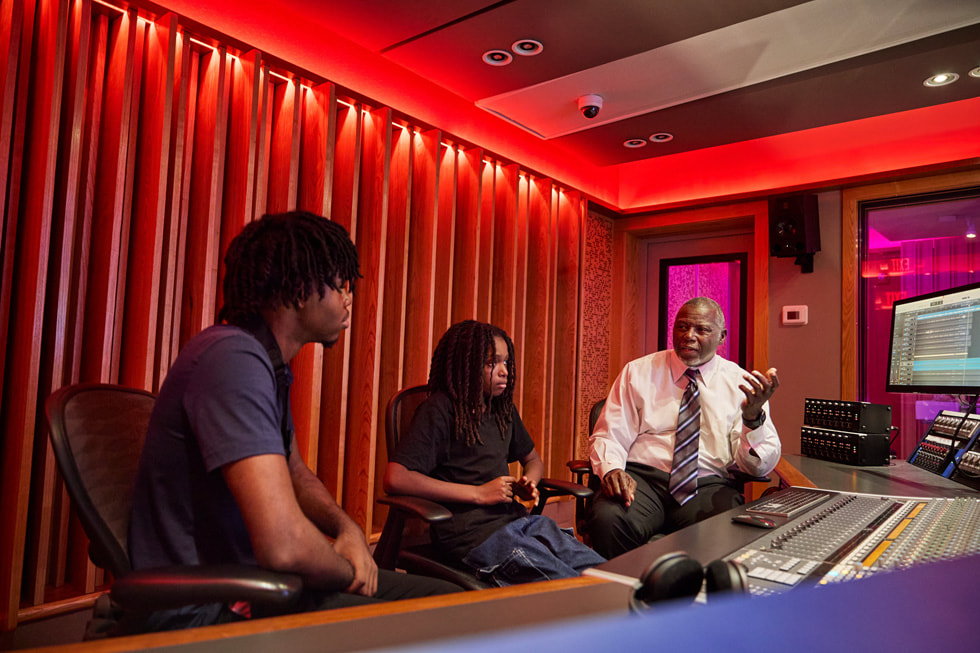
From left to right: Jacob Jones Jr. and Donte Allen with Dr. Daryl Dickerson in EMCM’s studio space, where Dr. Dickerson teaches his audio engineering class. “I’ve tried to diversify our curriculum as much as possible because not every kid wants to be a trumpet player or a drummer, and we don’t want to turn kids away,” he explains.
The audio engineering courses – made possible through Apple’s support – are among the center’s newer offerings for high school-aged students.
“Here in New Orleans, we have hotels, we have clubs, we have conventions, and we have probably more festivals than anybody in the world. And all of them need audio,” explains Dr. Daryl Dickerson, the center’s longtime director of music education. “This is a job you can learn now, and for the rest of your life, you can do it. If you learn how to capture and edit audio at a young age, you can evolve that into a career.”
For Jacob Jones Jr., a high school senior who plays the saxophone, trumpet, and piano, Dr. Dickerson’s Saturday afternoon audio engineering class has created a whole new framework for thinking about music.
“You can make a sound on an instrument, and that’s great,” says Jones. “But then when you play that sound back through the computer, you can expound on it, and play around and make something totally brand-new that no one has ever heard before.”
Outside of his classes, Jones often finds himself using the skills he’s learned in Logic and GarageBand on his iPhone whenever – and wherever – inspiration strikes. “GarageBand is really essential to me, because I’ll hear something and be like, ‘Wow, I just got to get it out.’ I’ll go on my iPhone, open GarageBand, be able to play out that melody, record it, and even make a whole song out of it,” he explains.
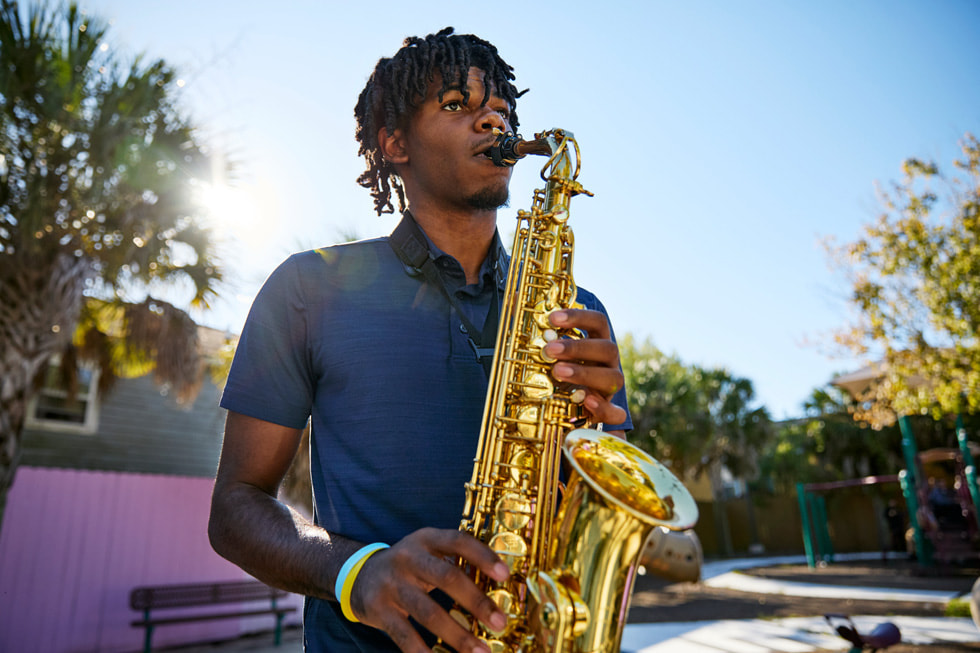
“When I switched over to jazz, I really fell in love with the saxophone,” says high school senior Jacob Jones Jr. “I love the intricacy and complexity of it, and all of the different subgenres within it.”
This same spirit of creative experimentation is fostered in the school’s coding courses, where students like Donte Allen, 14, are encouraged to merge their passion for music and the arts with the foundational technological skills they’re acquiring in class.
Allen has had a passion for music since he was in diapers. “My dad has a picture of me from when I was 6 months old with the trumpet in my carseat,” he notes with a smile.
But learning how to code has opened up new creative interests.
“Swift teaches you the fundamentals, and you can go on from there,” he explains of his newfound affinity for coding. “You can build your own apps, make your own games, and make your own stories… Music and Swift both help with my creativity.”
This type of exposure – across a wide range of creative and technological mediums, often with surprising points of intersection in between – is what it’s all about for the center’s faculty.
“These students want this type of education,” says Dr. Dickerson, whose next endeavor will be bringing podcasting classes into the center. “But if it’s not presented to them, they never get it. And it’s the same thing with music and everything else we do around here. So we’re always trying to present them with something new.”
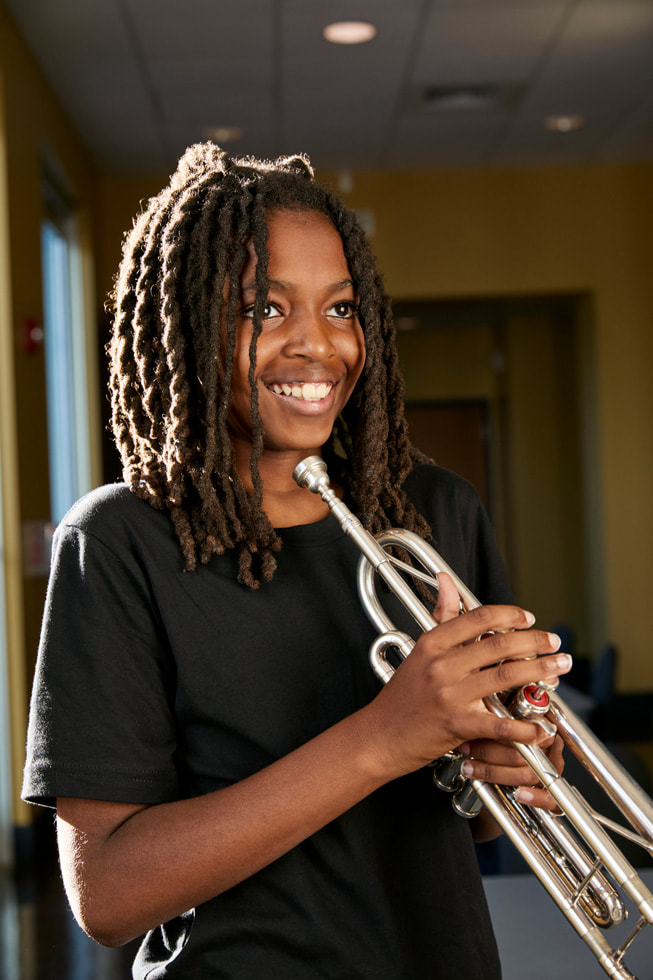
Donte Allen, 14, grew up attending second line parades and marching band performances with his family. “The trumpet means a lot to me because it’s my dad’s instrument,” he says. “It’s one of the connections between us.”
Beyond the football fervor already enveloping the Superdome, students from Arts New Orleans are putting the finishing touches on a project of their own. Their garden-themed mural, which will cover an exterior wall of the Orleans Justice Center along Interstate 10, highlights stories of previously incarcerated locals while also imparting a message of hope to the community.
The 6,600-square-foot piece was designed by participants in the Young Artist Movement (YAM), Arts New Orleans’ arts education and workforce development program, which works primarily with students ages 14 to 22. Through YAM, founded in 2016, local youth learn the mural-making process from guest artists and are then given the opportunity to create their own across the city. The participants will also complete the installation of the mural.
The design process for this particular mural began in the Procreate app on iPad. Using Apple Pencil, the 19 students designed the digital images that appear on the mural’s panels. Lead artists Journey Allen, Gabrielle Tolliver, and Jade Meyers then organized the final designs, and sent them to a mural cloth company to have them ghost-printed on large swaths of mural cloth. From there, the pieces are painted and will then be installed along the wall using a specific gel medium.
Allen, a visual artist and arts educator who serves as Arts New Orleans’ director of youth education, has enjoyed watching the students blossom. “I love to see the ones who are intimidated at first by the materials,” she shares. “But then when you connect with them and they begin to open up, the artwork becomes a source of transparency, a source of trust, where they share with you a little bit of who they are. Some of them never even really drew or painted before, and here they are creating this huge mural. They ask, ‘When are we going to do the next one?'”
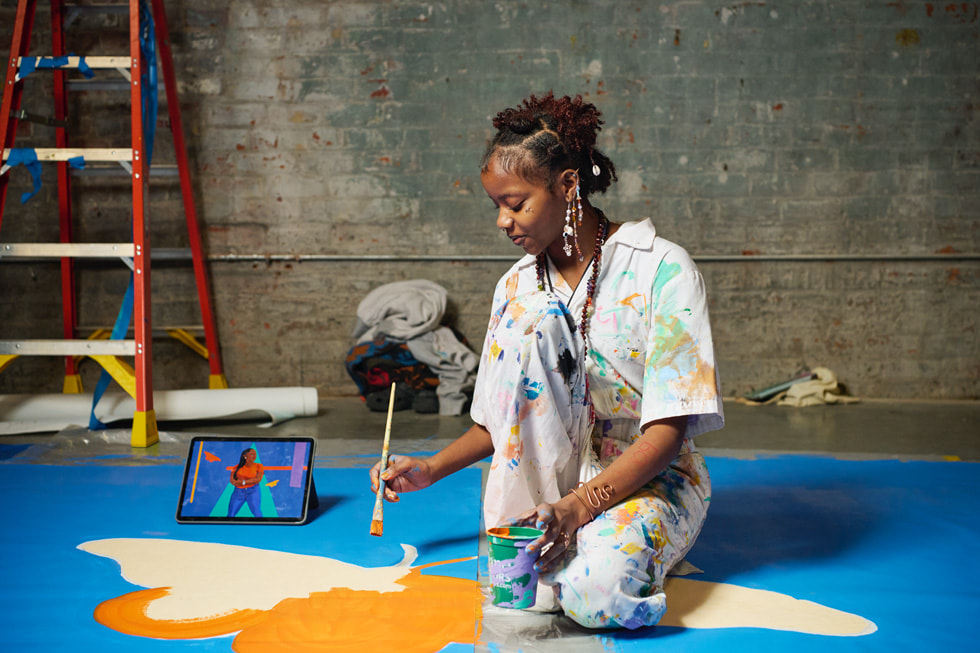
Covering a wall outside the Orleans Justice Center, Arts New Orleans’ latest mural was designed on iPad using Apple Pencil and Procreate.
For some of the young artists, the project holds an added layer of meaning – they came to YAM through its arts diversion program, an alternative to prosecution and incarceration for youth facing low-level, nonviolent offenses. Founded in 2021, it draws on the healing and restorative qualities of artistic expression, with the goal of students having their charges dismissed upon completion.
Arts New Orleans is also piloting a standalone arts diversion program this spring to help meet participants’ unique needs. “There are many things that they need to engage in, conversations that need to be had, that we can’t have amongst the main YAM group, which are kids who have not been impacted in the same way by the criminal justice system,” Allen explains. “Giving them their own program gives them a true opportunity to expand and move beyond whatever it is they are facing.”
The idea for YAM and its arts diversion program was sparked by now-retired Judge Arthur Hunter and Xavier University professor Ron Bechet, who is also an artist. Through his career as a police officer, a lawyer, and finally as a judge in his native New Orleans, Hunter had a firsthand look at the factors that lead to young people getting swept into the city’s criminal justice system and saw the potential for art to provide an alternate path.
“It’s not just the art – it’s an economic opportunity as well, where they should be able to make a living using their talent,” explains Hunter, a board member at Arts New Orleans. “That’s just as much a part of it as seeing that beautiful picture on a canvas.”
For Hunter, the timing of the mural’s unveiling couldn’t feel more fitting. “This project will be not just a culmination, but also I see it as the beginning of more art throughout the city, letting people know in the city, in the region, in the state, around the country, and around the world what kids can do in the city of New Orleans when it comes to art,” he says.
/Public Release. This material from the originating organization/author(s) might be of the point-in-time nature, and edited for clarity, style and length. Mirage.News does not take institutional positions or sides, and all views, positions, and conclusions expressed herein are solely those of the author(s).

